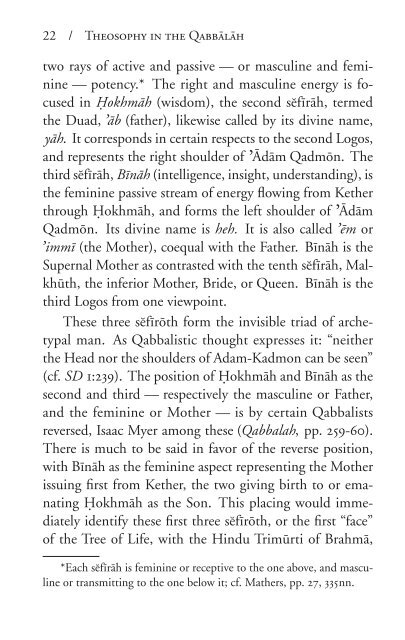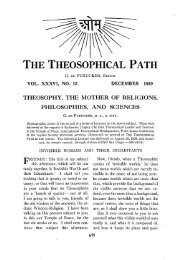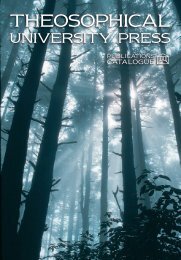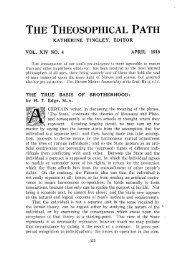Theosophy in the Qabbālāh - The Theosophical Society
Theosophy in the Qabbālāh - The Theosophical Society
Theosophy in the Qabbālāh - The Theosophical Society
You also want an ePaper? Increase the reach of your titles
YUMPU automatically turns print PDFs into web optimized ePapers that Google loves.
22 / <strong><strong>The</strong>osophy</strong> <strong>in</strong> <strong>the</strong> Qabbãlãh<br />
two rays of active and passive — or mascul<strong>in</strong>e and fem<strong>in</strong><strong>in</strong>e<br />
— potency.* <strong>The</strong> right and mascul<strong>in</strong>e energy is focused<br />
<strong>in</strong> Ýokhmãh (wisdom), <strong>the</strong> second sêfîrãh, termed<br />
<strong>the</strong> Duad, ¿ãb (fa<strong>the</strong>r), likewise called by its div<strong>in</strong>e name,<br />
yãh. It corresponds <strong>in</strong> certa<strong>in</strong> respects to <strong>the</strong> second Logos,<br />
and represents <strong>the</strong> right shoulder of ¿Ãdãm Qadmõn. <strong>The</strong><br />
third sêfîrãh, Bînãh (<strong>in</strong>telligence, <strong>in</strong>sight, understand<strong>in</strong>g), is<br />
<strong>the</strong> fem<strong>in</strong><strong>in</strong>e passive stream of energy flow<strong>in</strong>g from Ke<strong>the</strong>r<br />
through Ýokhmãh, and forms <strong>the</strong> left shoulder of ¿Ãdãm<br />
Qadmõn. Its div<strong>in</strong>e name is heh. It is also called ¿ÿm or<br />
¿ immî (<strong>the</strong> Mo<strong>the</strong>r), coequal with <strong>the</strong> Fa<strong>the</strong>r. Bînãh is <strong>the</strong><br />
Supernal Mo<strong>the</strong>r as contrasted with <strong>the</strong> tenth sêfîrãh, Malkhûth,<br />
<strong>the</strong> <strong>in</strong>ferior Mo<strong>the</strong>r, Bride, or Queen. Bînãh is <strong>the</strong><br />
third Logos from one viewpo<strong>in</strong>t.<br />
<strong>The</strong>se three sêfîrõth form <strong>the</strong> <strong>in</strong>visible triad of archetypal<br />
man. As Qabbalistic thought expresses it: “nei<strong>the</strong>r<br />
<strong>the</strong> Head nor <strong>the</strong> shoulders of Adam-Kadmon can be seen”<br />
(cf. SD 1:239). <strong>The</strong> position of Ýokhmãh and Bînãh as <strong>the</strong><br />
second and third — respectively <strong>the</strong> mascul<strong>in</strong>e or Fa<strong>the</strong>r,<br />
and <strong>the</strong> fem<strong>in</strong><strong>in</strong>e or Mo<strong>the</strong>r — is by certa<strong>in</strong> Qabbalists<br />
reversed, Isaac Myer among <strong>the</strong>se (Qabbalah, pp. 259-60).<br />
<strong>The</strong>re is much to be said <strong>in</strong> favor of <strong>the</strong> reverse position,<br />
with Bînãh as <strong>the</strong> fem<strong>in</strong><strong>in</strong>e aspect represent<strong>in</strong>g <strong>the</strong> Mo<strong>the</strong>r<br />
issu<strong>in</strong>g first from Ke<strong>the</strong>r, <strong>the</strong> two giv<strong>in</strong>g birth to or emanat<strong>in</strong>g<br />
Ýokhmãh as <strong>the</strong> Son. This plac<strong>in</strong>g would immediately<br />
identify <strong>the</strong>se first three sêfîrõth, or <strong>the</strong> first “face”<br />
of <strong>the</strong> Tree of Life, with <strong>the</strong> H<strong>in</strong>du Trimûrti of Brahmã,<br />
*Each sêfîrãh is fem<strong>in</strong><strong>in</strong>e or receptive to <strong>the</strong> one above, and mascul<strong>in</strong>e<br />
or transmitt<strong>in</strong>g to <strong>the</strong> one below it; cf. Ma<strong>the</strong>rs, pp. 27, 335 nn.













